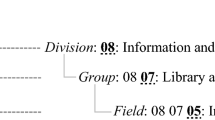Abstract
Interdisciplinary research has been encouraged through the policies of many governmental and institutional funding agencies in Korea. This paper measured the degrees of interdisciplinarity in individual and collaborative researches and analyzes the factors affecting it. This paper also examined flow of knowledge among different disciplines in science and engineering research using a database obtained from research proposals submitted to Korea Science and Engineering Foundation (KOSEF). The analysis indicated that 54.6% of collaborative research proposals were interdisciplinary, while 35.8% of individual research proposals were interdisciplinary. The analysis of knowledge inflow/outflow structure showed that Natural science served as a link between Life science and Engineering.
Similar content being viewed by others
References
BOURKE, B., BUTLER, L. (1998), Institutions and the map of science: matching university departments and fields of research. Research Policy, 26: 711-718.
DAVIDSE, R. J., VAN RAAN, A. F. J. (1997), Out of practice: impact on CERN, DESY and SLAC research to other than Physics. Scientometrics, 40: 171-193.
Higher Education Funding Council for England: HEFCE (1999), Interdisciplinary Research and the Research Assessment Exercise, RAE Publication 1/99.
HURD, J. (1992), Interdisciplinary research in the science: implication for library organization. College and Research Libraries, 53: 283-297.
KLEIN, J. T. (1990), Interdisciplinarity: History, Theory and Practice, Wayne State University Press.
KLEIN, J. T. (2000), A conceptual vocabulary of interdisciplinary science. In: P. WEINGART, N. STEHR (Eds) Practicing Interdisciplinarity, University of Toronto Press, pp. 3-24.
Korea Science and Engineering Foundation: KOSEF (2002), Annual Report.
LATTIMORE, R., REVESZ, J. (1996), Australian Science: Performance from Published Papers. Bureau of Industry Economics, Report 96/3, Australian Government Printing Office, Canberra.
OECD (1998), Interdisciplinarity in Science and Technology, Directorate for Science, Technology and Industry, OECD, Paris.
PORTER, A. L., CHUBIN, D. E. (1985), An indicator of cross-disciplinary research. Scientometrics, 8: 161-176.
QIN, J., LANCASTER, F. W., ALLEN, B. (1997), Types and levels of collaboration in interdisciplinary research in the sciences. Journal of the American Society for Information Science, 48: 893-916.
RINIA, E. J., VAN LEEUWEN, TH. N., VAN VUREN, H. G., VAN RAAN, A. F. J. (2001), Influence of interdisciplinarity on peer-review and bibliometric evaluations in physics research. Research Policy, 30: 357-361.
SALTER, L., HEARN, A. (1996), Outside the Lines: Issues in Interdisciplinary Research. McGill-Queen.s University Press.
VAN RAAN, A. F. J., VAN LEEUWEN, TH. N. (2002), Assessment of the scientific basis of interdisciplinary, applied research application of bibliometric methods in nutrition and food research. Research Policy, 31: 611-632.
WEINGART, P., STEHR, N. (Eds) (2000), Practicing Interdisciplinarity. University of Toronto Press.
Author information
Authors and Affiliations
Corresponding author
Rights and permissions
About this article
Cite this article
Song, CH. Interdisciplinarity and knowledge inflow/outflow structure among science and engineering research in Korea. Scientometrics 58, 129–141 (2003). https://doi.org/10.1023/A:1025483625299
Issue Date:
DOI: https://doi.org/10.1023/A:1025483625299




